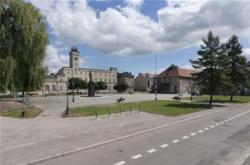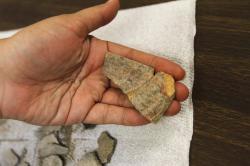INSTITUT SUPERIEUR D'ANTHROPOLOGIE
INSTITUTE OF ANTHROPOLOGY
ONLINE COURSES / COURS A DISTANCE
SUMMER TERM : JULY 2014
REGISTER NOW
POLOGNE –  Radom - Archaeologists found the foundations of medieval town hall in Radom city square. The location will be specially marked in the revitalization of the square floor, planned by the city for the next year. Town hall, like Radom castle and parish church, was built in mid-14th century, during the rule of Casimir the Great, who founded Radom according to the Magdeburg Law. This marked the beginning of development of a new Casimir Town. Chief archaeologist supervising the excavations at the Radom market, Grzegorz Barczyk told PAP that in the study archaeologists uncovered the town hall foundations made of stone with lime mortar. Barczyk emphasised that excavations confirmed the original location of the town hall. Uncovered foundations indicate that the building on a rectangular plan with dimensions of 21 m by 10.5 m, was situated on the east - west axis. "We have confirmed that the first town hall in Radom was not located in the centre of the square, as in other medieval Casimir towns, but closer to the western side" - noted the archaeologist. Hall was situated opposite the existing Lublin Gate and on the extension of today’s Rwańska street, which used to be the road leading to Lublin. During excavations archaeologists found many fragments of pottery from various periods, from the fourteenth century to the present. These are fragments of pottery and glass vessels, stove tiles. Among the finds are also two mysterious balls of sandstone, with diameters of 7 mm and 10 mm. According to Barczyk, they could be cannon balls, although he noted that cannonballs were usually made of stronger material; they could also be façade ornaments. The first town hall was built around Radom in mid-14th century. In the beginning of the 16th century it was rebuilt. The building was destroyed during the Swedish invasion, in the 18th century also destroyed by fire. Rebuilt in 1790, in later years it fell into disrepair. In 1818 the decision was made on its demolition.
Radom - Archaeologists found the foundations of medieval town hall in Radom city square. The location will be specially marked in the revitalization of the square floor, planned by the city for the next year. Town hall, like Radom castle and parish church, was built in mid-14th century, during the rule of Casimir the Great, who founded Radom according to the Magdeburg Law. This marked the beginning of development of a new Casimir Town. Chief archaeologist supervising the excavations at the Radom market, Grzegorz Barczyk told PAP that in the study archaeologists uncovered the town hall foundations made of stone with lime mortar. Barczyk emphasised that excavations confirmed the original location of the town hall. Uncovered foundations indicate that the building on a rectangular plan with dimensions of 21 m by 10.5 m, was situated on the east - west axis. "We have confirmed that the first town hall in Radom was not located in the centre of the square, as in other medieval Casimir towns, but closer to the western side" - noted the archaeologist. Hall was situated opposite the existing Lublin Gate and on the extension of today’s Rwańska street, which used to be the road leading to Lublin. During excavations archaeologists found many fragments of pottery from various periods, from the fourteenth century to the present. These are fragments of pottery and glass vessels, stove tiles. Among the finds are also two mysterious balls of sandstone, with diameters of 7 mm and 10 mm. According to Barczyk, they could be cannon balls, although he noted that cannonballs were usually made of stronger material; they could also be façade ornaments. The first town hall was built around Radom in mid-14th century. In the beginning of the 16th century it was rebuilt. The building was destroyed during the Swedish invasion, in the 18th century also destroyed by fire. Rebuilt in 1790, in later years it fell into disrepair. In 1818 the decision was made on its demolition.
http://www.naukawpolsce.pap.pl/en/news/news,401061,archaeologists-found-the-foundations-of-medieval-town-hall-
USA –  Fort Harrel - It was one of several forts the U.S. Army built in South Florida in the 1800s, allowing soldiers fighting the Seminole Wars to rest and regroup. Fort Harrell was one of the more obscure outposts, wedged into a rugged swamp area, accessible mainly by boat. No great battles were waged there and no famous generals used it. Yet three amateur explorers, led by a high school chemistry teacher, believe they have found its exact site and consider it an important historic find. "It needs to be preserved and memorialized," said Shawn Beightol, who led the expeditions to the site in the Big Cypress Preserve in Collier County.The three spent dozens of hours studying historic war maps, engineering surveys and old aerial photos. Then they made five forays into the Everglades this year to locate the site. On the last one, in June, Pernas spotted a clearing with post holes in limestone, used to support the foundation walls of the fort. "Once we saw the holes, I knew we had found it," Pernas said.The trio now plans to have a professional surveyconducted to document the fort site, about five miles south of Mile Marker 61 on the Tamiami Trail. If confirmed as Fort Harrell, it would be a significant find, said Bob Carr, a Davie archaeologist often hired to investigate ancient artifacts found at construction sites. "Any vestige of the Seminole War period in South Florida would be significant because few sites have been preserved and not all have been found," said Carr, of the Archaeological and Historical Conservancy. Careful not to disturb the site, they marked its boundaries with yellow tape and estimated the fort structure to be about 135 feet long and 45 feet wide. There was evidence of a protected enclosure, possibly used for soldiers to take aim at intruders, and a boat landing on the nearby Big Cypress New River.
Fort Harrel - It was one of several forts the U.S. Army built in South Florida in the 1800s, allowing soldiers fighting the Seminole Wars to rest and regroup. Fort Harrell was one of the more obscure outposts, wedged into a rugged swamp area, accessible mainly by boat. No great battles were waged there and no famous generals used it. Yet three amateur explorers, led by a high school chemistry teacher, believe they have found its exact site and consider it an important historic find. "It needs to be preserved and memorialized," said Shawn Beightol, who led the expeditions to the site in the Big Cypress Preserve in Collier County.The three spent dozens of hours studying historic war maps, engineering surveys and old aerial photos. Then they made five forays into the Everglades this year to locate the site. On the last one, in June, Pernas spotted a clearing with post holes in limestone, used to support the foundation walls of the fort. "Once we saw the holes, I knew we had found it," Pernas said.The trio now plans to have a professional surveyconducted to document the fort site, about five miles south of Mile Marker 61 on the Tamiami Trail. If confirmed as Fort Harrell, it would be a significant find, said Bob Carr, a Davie archaeologist often hired to investigate ancient artifacts found at construction sites. "Any vestige of the Seminole War period in South Florida would be significant because few sites have been preserved and not all have been found," said Carr, of the Archaeological and Historical Conservancy. Careful not to disturb the site, they marked its boundaries with yellow tape and estimated the fort structure to be about 135 feet long and 45 feet wide. There was evidence of a protected enclosure, possibly used for soldiers to take aim at intruders, and a boat landing on the nearby Big Cypress New River.
http://articles.sun-sentinel.com/2014-07-02/news/fl-historic-fort-found-20140702_1_everglades-fort-site-seminole-war
BULGARIE –  Pernik - Archaeologists found the grave of a young woman, laid to rest with all her jewels in an area near Bulgaria's Pernik, reports Darik radio. Together with the skeleton of the young woman, who died in the end of the XVIII c. were found the bones of a baby, which was most likely in its mother's womb when she died. Experts in anthropology are still to define the baby's exact age. According to archaeologist Vasilka Paunova, the recently married women used to wear their best clothes and all jewels they got as wedding presents for up to a year after the marriage. According to ethnologist Tsvetana Manova, the woman was not of a rich family, but was buried with all her jewelry, including two pairs of copper bracelets, bead necklaces, pendants of sea shells, copper and silver coins and a bronze ring with a green stone.
Pernik - Archaeologists found the grave of a young woman, laid to rest with all her jewels in an area near Bulgaria's Pernik, reports Darik radio. Together with the skeleton of the young woman, who died in the end of the XVIII c. were found the bones of a baby, which was most likely in its mother's womb when she died. Experts in anthropology are still to define the baby's exact age. According to archaeologist Vasilka Paunova, the recently married women used to wear their best clothes and all jewels they got as wedding presents for up to a year after the marriage. According to ethnologist Tsvetana Manova, the woman was not of a rich family, but was buried with all her jewelry, including two pairs of copper bracelets, bead necklaces, pendants of sea shells, copper and silver coins and a bronze ring with a green stone.
http://www.novinite.com/articles/161920/Archaeologists+Discover+Richly+Decorated+XVIII+c.+Grave
USA –  Salmon Ruins - Workers widening a northwestern New Mexico highway bordering an archaeological site found artifacts that officials said might be from the ancient Puebloan culture. The pottery pieces and fragments of charcoal, burned corn fibers and other material were found last week when a laborer noticed something red and black glinting in the sun, the Daily Times (http://bit.ly/1ziWSRj) reported Sunday. The Mountain States Constructors Inc. crew was widening U.S. Highway 64 along the Salmon Ruins in Bloomfield when workers made the find. "I could see the reddish color with hand-painted black lines and knew this was something," Beyale said. "It was a nice piece with a pretty good size to it." Beyale, 32, said he's been to Mesa Verde National Park and Chaco Canyon National Historic Park and recognized the pottery's painted black lines. Baker said he thought it might be Pueblo III-era — between 1100 and 1300 A.D. — pottery based on the design on the shards.
Salmon Ruins - Workers widening a northwestern New Mexico highway bordering an archaeological site found artifacts that officials said might be from the ancient Puebloan culture. The pottery pieces and fragments of charcoal, burned corn fibers and other material were found last week when a laborer noticed something red and black glinting in the sun, the Daily Times (http://bit.ly/1ziWSRj) reported Sunday. The Mountain States Constructors Inc. crew was widening U.S. Highway 64 along the Salmon Ruins in Bloomfield when workers made the find. "I could see the reddish color with hand-painted black lines and knew this was something," Beyale said. "It was a nice piece with a pretty good size to it." Beyale, 32, said he's been to Mesa Verde National Park and Chaco Canyon National Historic Park and recognized the pottery's painted black lines. Baker said he thought it might be Pueblo III-era — between 1100 and 1300 A.D. — pottery based on the design on the shards.
http://www.startribune.com/nation/266033651.html